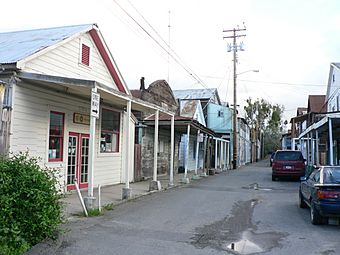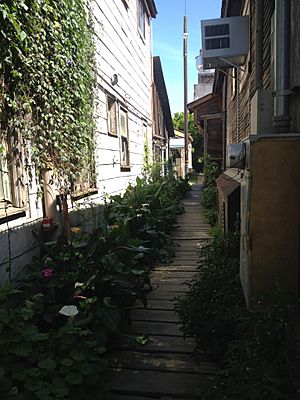Locke, California facts for kids
Locke, also known as Locke Historic District, is a small town in the Sacramento–San Joaquin River Delta in California, United States. This 14-acre town (5.7 ha) was first built between 1893 and 1915. It is about one mile north of Walnut Grove in Sacramento County.
Locke is mainly a farming community. It is located near State Route 160, south of the city of Sacramento. In 1971, it was added to the National Register of Historic Places. In 1990, it became a National Historic Landmark District. This was because it is a special example of a historic Chinese American farming town. In 2021, about 100 people lived there. Chinese Americans are no longer the main group living in Locke.
The town was first called Lockeport. Its name was shortened to "Locke" in 1920. It began where two railroads met. George W. Locke, who founded the town, and his business partner, Samuel P. Lavenson, owned the land. Both men had come to California during the California Gold Rush.
After a fire destroyed the Chinese area of nearby Walnut Grove in 1915, many Chinese immigrants moved to Locke. They helped the town grow even more. Chinese-owned shops and a Chinese language school were started. Locke continued to be a busy Chinese American farming community. But after World War II, younger people began to leave. They moved to cities for better schools and jobs.
Contents
The Early History of Locke
The land where Locke was built was once swampland. For hundreds of years, Native American Miwok and Maidu tribes lived there. There are still tribal burial grounds on the land in Locke.
Reclaiming the Land
In the 1800s, California passed laws like the Swampland Reclamation Act of 1861. These laws aimed to use and stabilize lands that seemed empty. This meant draining the Delta wetlands and building levees. Levees are walls that control floods in places like Locke. Many poor Chinese immigrants were hired for this very hard work.
These workers were often paid less than one dollar a day. They built hundreds of miles of levees in water that was waist-deep. Diseases like malaria were common. They reclaimed a total of 88,000 acres (36,000 ha) of land.
Building the First Structures
In 1912, three Chinese business owners decided to build in Locke. Two were from Vorden, and one was from Walnut Grove. They hired workers to build three buildings. Chan Tin Sin built a store that sold dry goods and beer. Yuen Lai Sing built a gambling hall. Owyang Wing Cheong built the Lockeport Hotel & Restaurant.
After these first buildings, the Canton Hotel was built. Several other buildings followed. Eventually, seven structures formed the small town of Lockeport. Some business owners hoped to attract riverboat and train passengers. But this idea did not work well. This was due to the unfair treatment of Chinese people at that time.
A New Home for Chinese Immigrants
On October 7, 1915, a fire accidentally destroyed the Chinese area of Walnut Grove. After the fire, a group of Chinese immigrants moved to Locke. They were from what is now Zhongshan in southern China's Guangdong province. Lee Bing, a Chinese American businessman, led this group.
Some Chinese settlers who spoke Taishanese stayed in Walnut Grove to rebuild. But the Chinese settlers from Zhongshan, who spoke Cantonese, moved to Locke. They wanted to create their own town. They leased the land from George Locke. This was because California law at the time, called the California Alien Land Law of 1913, stopped Asian immigrants from buying farmland.
Life and Community in Locke
Locke had a large Chinese population. Because of this, the Chinese Kuomintang political party once had a local group there. As the town grew, it became known for its lively nightlife. Some people even called it "California's Monte Carlo".
Farming and Daily Life
The number of people in Locke grew during the farming and harvest seasons. Most of the reclaimed land in the Sacramento-San Joaquin Delta, including Locke, was used for cash crops. These crops included asparagus, potatoes, sweet potatoes, white beans, pears, and apples.
During harvest, as many as 1000 to 1500 Chinese people would live in Locke. Farmhands shared rooms in boarding houses. Chinese residents living in homes behind Main Street also took in Chinese farm workers.
Chinese immigrants in Locke started farming methods that are still used today. These include hiring workers for specific tasks, tenant farming (renting land to farm), sharecropping (sharing crops with the landowner), and the piece wage system (getting paid for each piece of work done).
There was a community garden in the back of town. There was also a special oven to make roast pigs on Sundays. Chinese communities often came together to support each other. This was important because of difficult working and social conditions. Laws like the Chinese Exclusion Act made life harder for them. They created community gardens where they grew Chinese cabbage, snow peas, leafy vegetables, winter melon, and tomatoes.
Life in Locke was often harmonious. Chinese mothers would help care for each other's children. This allowed other mothers to work at the cannery across the Sacramento River.
Changes Over Time
During the 1940s and 1950s, many Chinese Americans from Locke began to move away. They had received better education. They started to join the American mainstream. They moved out of rural Locke and into the growing suburbs of bigger cities.
The Locke Historic District is bordered by the Sacramento River on the west. Locke Road is to the north, Alley Street to the east, and Levee Street to the south. The district was added to the National Register of Historic Places on May 6, 1971.
Recent History
In 1977, a developer from Hong Kong bought the town from the Locke family. In 2002, the Sacramento Housing and Redevelopment Agency bought it. In 2004, the agency finally allowed people who had lived there for many years to buy their land. There were plans to turn Locke into a housing area and a tourist attraction.
At the north end of Main Street, the Locke Boarding House museum has been restored. It is now owned by California State Parks. Volunteers work there daily. The Town of Locke celebrated its 100th anniversary in 2015 with a big gathering on May 9.
On July 3, 2016, a fire started on the second floor of the Locke Country Store on Main Street. Two apartments were located there. The fire completely destroyed the second floor and a building behind the store. No one was hurt.
The Locke Historic District was named a National Historic Landmark on December 14, 1990.
Post Office Services
Locke once had its own ZIP Code, 95649. But this code was stopped when the post office closed on August 2, 1963. Now, Locke uses Walnut Grove's ZIP code, which is 95690. The community is also within area code 916.







